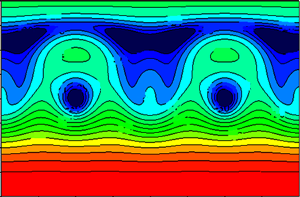Electrodynamic characteristics of fields of two orthogonal pairs of in-phase excited impedance dipoles located parallel to square screen
DOI:
https://doi.org/10.3103/S0735272723080034Keywords:
antenna, impedance dipole, square screen, diffracted field, radiation pattern, RP, ellipticity coefficient, surface impedance, polarizationAbstract
Three-dimensional vector problems of diffraction of fields of two parallel impedance dipoles and two orthogonal pairs of such dipoles located parallel to a perfectly conducting rectangular screen at its edges have been solved by the method of uniform geometric diffraction theory using uniform asymptotic expressions for diffracted fields excited by a dipole at the edge of a perfectly conducting half-plane. Approximate asymptotic expressions for the current distribution in a thin horizontal impedance dipole located above a perfectly conducting infinite plane are used to determine the current distribution in impedance dipoles. Fast computational programs have been developed to determine the surface impedances of pairs of dipoles above the screen, provided that the resonant or circularly polarized radiation is generated in the direction normal to the screen. To synthesize the circular polarization of the field in the direction of the normal to the screen and simultaneously to provide the axial symmetry of the radiation patterns (RP), it was proposed to use two pairs of in-phase excited impedance dipoles with orthogonal orientation and different corresponding surface impedances. It has been proved that the RP, according to the field power of the resonant and circularly polarized four-vibrator radiators located at the distance of a quarter of antenna operating wavelength above a square screen with a side of 1.2 wavelengths and a distance between parallel dipoles of 0.51 of wavelength have axial symmetry in the sector of observation angles ±45° to relative levels of –12 dB. The main lobes of the RP in terms of orthogonal field components in the main observation planes converge to a relative level of –20 dB in the sector of angles ±70° from the normal to the screen. At the same time, in the case of a circularly polarized radiator, the value of the ellipticity coefficient is not less than 0.9. The calculated RP was verified using the Feko program.
References
- C. A. Balanis, Antenna Theory: Analysis and Design. New Jersey: Wiley, 2016, uri: https://www.wiley.com/en-us/Antenna+Theory%3A+Analysis+and+Design%2C+4th+Edition-p-9781118642061.
- Y. B. Karandikar, “Pattern studies of two parallel dipoles above ground plane in eleven configuration as feed for reflector antenna,” IEEE Antennas Wirel. Propag. Lett., vol. 9, pp. 558–561, 2010, doi: https://doi.org/10.1109/LAWP.2010.2051657.
- H. Huang, X. Li, S. Liu, Y. Liu, “A new method of antenna height reduction based on half-sized full-wave dipole,” IEEE Trans. Antennas Propag., vol. 71, no. 8, pp. 6936–6940, 2023, doi: https://doi.org/10.1109/TAP.2023.3274291.
- H. Huang, X. Li, Y. Liu, “A wideband directional antenna based on hybrid mode dipole,” IEEE Trans. Antennas Propag., vol. 71, no. 9, pp. 7615–7619, 2023, doi: https://doi.org/10.1109/TAP.2023.3298135.
- M. Seki, K. Cho, “A design of dual-band dipole antenna with reflector and FSR using genetic algorithm,” in 2020 International Symposium on Antennas and Propagation (ISAP), 2021, pp. 479–480, doi: https://doi.org/10.23919/ISAP47053.2021.9391217.
- J. Tamura, H. Arai, “Reflector backed dipole antenna array employing side reflectors for null depth improvement,” in 2021 IEEE International Symposium on Antennas and Propagation and USNC-URSI Radio Science Meeting (APS/URSI), 2021, pp. 717–718, doi: https://doi.org/10.1109/APS/URSI47566.2021.9703736.
- P. Ramanujam, V. Prasad, K. Arunachalam, “Design of reflector based dipole antenna for sub-6GHz 5G applications,” in 2022 IEEE Microwaves, Antennas, and Propagation Conference (MAPCON), 2022, pp. 1661–1665, doi: https://doi.org/10.1109/MAPCON56011.2022.10047069.
- L.-H. Ye, L. Yuanjun, D.-L. Wu, “Dual-wideband dual-polarized dipole antenna with T-shaped slots and stable radiation pattern,” IEEE Antennas Wirel. Propag. Lett., vol. 21, no. 3, pp. 610–614, 2022, doi: https://doi.org/10.1109/LAWP.2021.3139454.
- L. Pollayi, D. R. Krishna, “Design and analysis of wideband cross dipole antenna with bent arms for base station applications,” Prog. Electromagn. Res. C, vol. 139, pp. 119–127, 2024, doi: https://doi.org/10.2528/PIERC23061104.
- L. T. C. Ha, S. X. Ta, N. X. Quyen, N. K. Kiem, D.-N. Chien, “High-isolation wide-beam dual-polarized antenna utilizing symmetrical feeding,” Prog. Electromagn. Res. M, vol. 111, pp. 53–63, 2022, doi: https://doi.org/10.2528/PIERM22050201.
- N. P. Yeliseeva, M. M. Gorobets, Diffraction of wire antenna radiation using rectangular and angular screens, [in Ukrainian]. Kharkiv: KhNU, 2009.
- J. B. Keller, “Geometrical theory of diffraction,” J. Opt. Soc. Am., vol. 52, no. 2, p. 116, 1962, doi: https://doi.org/10.1364/JOSA.52.000116.
- V. A. Borovikov, B. E. Kinber, Geometrical theory of diffraction, [in Russian]. Moscow: Svyaz, 1978.
- R. G. Kouyoumjian, P. H. Pathak, “A uniform geometrical theory of diffraction for an edge in a perfectly conducting surface,” Proc. IEEE, vol. 62, no. 11, pp. 1448–1461, 1974, doi: https://doi.org/10.1109/PROC.1974.9651.
- P. Pathak, “High frequency techniques for antenna analysis,” Proc. IEEE, vol. 80, no. 1, pp. 44–65, 1992, doi: https://doi.org/10.1109/5.119566.
- N. N. Gorobets, N. P. Yeliseyeva, “Electrodynamic characteristics of a four-vibrator radiator with a square screen,” J. Commun. Technol. Electron., vol. 60, no. 5, pp. 454–469, 2015, doi: https://doi.org/10.1134/S1064226915040075.
- Y. V. Vandakurov, “Diffraction of electromagnetic waves radiated by arbitrarily oriented electric or magnetic dipole on ideally conductive half-plane,” J. Exp. Theor. Phys., vol. 26, no. 1, pp. 3–18, 1954.
- S. L. Berdnik, V. Katrich, M. V. Nesterenko, Y. M. Penkin, “Electromagnetic waves radiation by a vibrators system with variable surface impedance,” Prog. Electromagn. Res. M, vol. 51, pp. 157–163, 2016, doi: https://doi.org/10.2528/PIERM16091605.
- N. P. Yeliseyeva, A. N. Gorobets, V. A. Katrich, M. V. Nesterenko, “Radiation fields of a system of two impedance crossed vibrators excited in-phase and placed over a rectangular screen,” Prog. Electromagn. Res. B, vol. 77, pp. 71–84, 2017, doi: https://doi.org/10.2528/PIERB17052503.
- N. P. Yeliseyeva, S. L. Berdnik, V. A. Katrich, M. V. Nesterenko, “Electrodynamic characteristics of horizontal impedance vibrator located over a finite-dimensional perfectly conducting screen,” Prog. Electromagn. Res. B, vol. 63, pp. 275–288, 2015, doi: https://doi.org/10.2528/PIERB15043003.
- N. N. Bogolyubov, Y. A. Mitropol’skii, Asymptotic methods in the theory of nonlinear oscillations, [in Russian]. Moscow: Nauka, 1974.
- M. Born, E. Wolf, Principles of Optics. Oxford: Pergamon Press, 1975.


